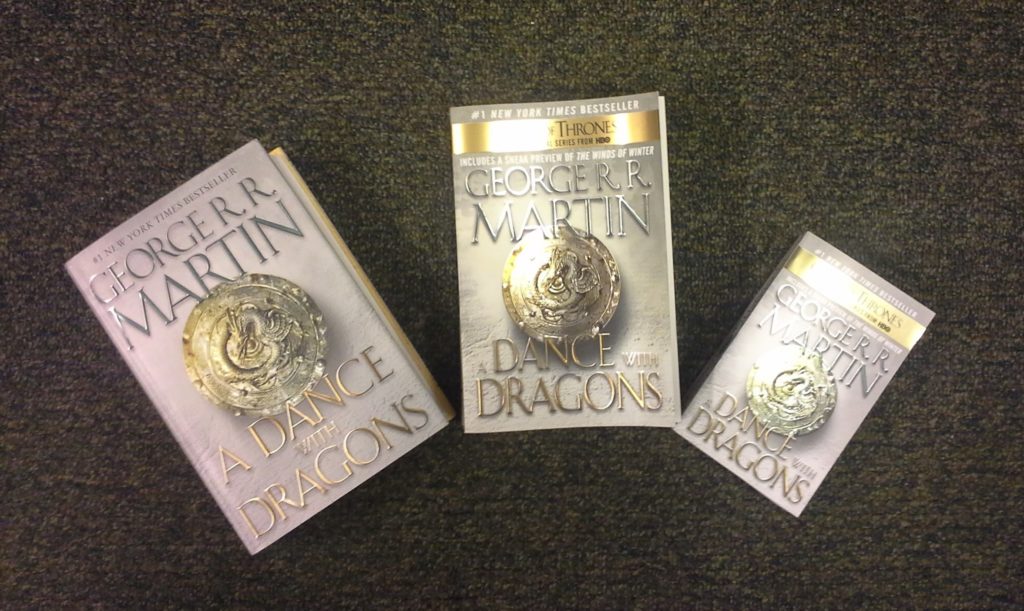
A Dance of Dragons: Hardcover, Trade Paperback, Mass Market
Welcome to the bookstore, where conversations such as this can happen:
Customer: Hi. I know this book just came out, but can I get it in paperback?
Me: I’m sorry, ma’am, but it’s only available in hardcover.
Customer: Well, I saw it at Target and they had it in paperback.
Me: Ma’am, if you find the paperback at Target, I would love for you to bring it in here so I can see it for myself.
“Is this in paperback?” is a question booksellers probably hear the most. No. The answer is always no. Quite often the customer doesn’t understand why there isn’t a paperback, despite the fact that as a business standpoint alone that would be a stupid thing for publishers to do. Sometimes they’ll accept the answer. Other times they’ll walk away in a huff, chagrined that they have to pay $20 or more for said hardcover. And some people will put the book back and decide to wait an extra year just to save that handful of cash.
Why isn’t there a paperback yet? Before we dive into that, let’s do a quick lesson on the formats of books out there since people don’t often realize that when they ask that, they’re asking for two possibilities.

Hardcover with Dust Jacket

Trade Cloth
Hardcover (aka Trade Cloth): This is what it sounds like: a hardcover book with a dust jacket. Not every hardcover has a dust jacket (some publishers print directly on the cover itself, such as the case in cookbooks or textbooks), but for fiction, this is often the first format publishers will release. Though some people may wonder why it’s also called “Trade Cloth,” and that’s because in the past books were indeed bound with cloth covers. Older books with covers that feel textured and have titles and images stamped on them? Cloth cover. The name has simply hung around.

Trade paperbacks
Trade Paperback: This is a larger-sized version of paperback book that often costs around $15. This is usually what comes next after hardcover.

Mass Market Paperbacks
Mass Market Paperback: These are the little paperbacks that you’ll find just about everywhere. They typically cost around $7 and usually come out last.
So why isn’t this brand-spanking new book in paperback? The simplest answer boils down to this:
Too many people are willing to pay for it in hardcover.
This is especially true for popular authors. Stephen King, J.R. Ward, Rick Riordan, Diana Gabaldon, and so forth. They will all be released in hardcover first — often in promotional space. Readers eagerly awaiting the next release will snap those books up no matter what format they’re in and pay for them without a second thought. And the numbers are too great for publishers to suddenly change the format and in turn, change the price.
You’ll also find hardcovers for new authors. Publishers do so because they believe the author will sell enough to make back the money spent on advances and so forth. You can also find hardcovers in numerous other areas — biography, cookbooks, business, etc. If the publisher believes the book will sell enough in that format, then that’s precisely what they’ll do. Hardcover books are also popular with libraries because they hold up much better over time than paperbacks, and when a library system buys brand new hardcover books in bulk, that’s a lot of dollars.
And you? Unfortunately, you have no choice but to wait.
Typically the time between hardcover and trade paperback is a year. If it’s shorter, consider yourself lucky. If it’s longer, it’s because the book is popular and the publisher is still making enough to justify the format. This is why when you look at the publication dates of certain books, The Hunger Games for example, you might find two years between dates. Some books, such as cookbooks and business books, may never come out in another format. Cookbooks especially are one format only since the HC-TP-MM formula doesn’t make sense for them.
As for the dates between a trade paperback release and a mass market release, those can vary. Sometimes there could be as much as another year between release dates. Other instances they’ll be released at the same time. Again, it all depends upon the publisher and what they decide is best for the book.
Of course, there are always exceptions. Parents looking for books like Diary of a Wimpy Kid will swear up and down that it’s available in paperback, and it is — directly through Scholastic book fairs. They’re the publisher, and that’s how they’ve decided to release the books; hardcover only to stores, paperback through their book fairs, and that’s the only way to get it. Some genres, such as science fiction, fantasy, mystery, and romance, if they begin as hardcover will often skip the trade paperback format and go straight to mass market. Or they may skip hardcover entirely and start out as a trade or mass market. Romance tends to skew toward mass market the most. Fiction, on the other hand, if it skips hardcover, then you’ll most likely find it in trade paper. The mass market selection of fiction isn’t as large as it used to be.
All this happens because publishers and the rest of the book-buying world pays attention to trends concerning cost, consumer buying, and so on. For example, rewind back a decade or two and you’d find tons of teen books in mass market format. Now? Hardcover and trade. It follows more closely to the adult model — and it wouldn’t surprise me if it’s also because teens are happy to spend money on their books. Likewise, a teen trade doesn’t cost the same as an adult trade; $9.99 to $14.99. And when a mass market could be $6.99, why not boost it up a few more dollars and offer the trade?
Things fluctuate in the publisher world just as they do anywhere else. Who knows? Perhaps in a few more decades mass markets will be king again. But that hardcover that just came out?
No, it’s not in paperback yet.
***
Author’s Note: I feel it is important to mention that publishers aren’t the only ones making money in this situation — so is the author of the book. The next time you find yourself teetering between hardcover now and paperback later, think of it this way: if you buy the hardcover now, you’re supporting someone who has poured a year (quite possibly more) of their life into that book for you to enjoy. If you still don’t want to, that’s fine, but for the love of books, PLEASE do not complain about price to the booksellers as you’re basically saying you don’t want to pay the author for all their hard work — especially since authors have little to no say over their book’s format.

I know when I was in high school and college, getting my books as cheaply as possible (and no, I’m not talking about textbooks here) was really important. I’d wait for paperbacks, OR I’d wait the year for the books to show up majorly discounted at Book Warehouse. Sometimes I’d get lucky at my local used bookstore, and I’d use the library if I was REALLY jonesing to read the latest Star Wars hardcover.
But that was teenager-no-money me.
Well, it’s one thing if you can’t afford a paperback or just don’t have a preference for hardcover. Personally, I’m like Kelly in that I really have to like the book and want to own it in that format to buy hardcover. But it’s something else entirely just to complain about the price – especially to booksellers who have zero control over the price. ;D
I am a paperback person. Cost just adds up if you buy a lot of books, plus I just find it more comfortable to hold paperbacks over hardcovers because of the weight and size. Then on top of that, I like all the books in a series looking the same. Do not get me started on series that start out in paperback then suddenly switch to hardcover releases because of their popularity!
That is SO a pet peeve of mine. Din’t get me wrong: I’m happy the author is making more money. But it ruins the aesthetics of my collection! Hence, Kindle!
I would compare this to movies. After a theatrical release and a subsequent release to TV/cable, the DVD version will come out usually from six to twelve months, sooner if it’s a box office disaster.
I don’t like to buy hardcover unless it’s something that I am absolutely sure that I will love. I waited the year for Dances with Dragons to come out in paperback but I may break down the next one in hardcover. If something is only available in hardcover, I will usually order it from the library rather than pay $25. Hardcover price is just too much unless it’s something that I know I will be keeping and re-reading. I don’t mind paying full-price for cookbooks because I know I will get the use out of them. But I am fairly frugal (although I draw a line at the antics of the Extreme Cheapskates who eat cat food and buy used underwear).
Does anyone know why they’re making mass markets bigger now? Not like, trade sized big, but taller. I know someone that had a bookshelf custom made to fit the size of mass markets, and they’re very upset about it.
You know, I used to know the answer to that question, but for the life of me, I can’t remember now. But it’s definitely screwing up the aesthetics of my collection!
That one I can’t answer, unfortunately. I meant to include the one Stephen King book I have in the mass market picture – simply because it’s one of those oddly tall ones. Maybe it gives them the chance to justify the $9.99 price? That’s what I usually see those at instead of the cheaper MM prices. But I don’t know for sure.
The price point is probably at least part of it.